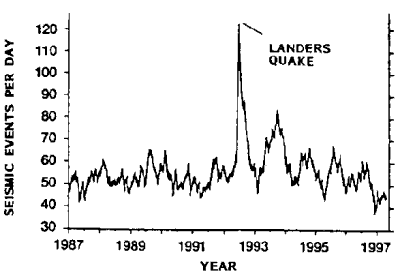 |
Science Frontiers ONLINE No. 116: Mar-Apr 1998 |
|
|
Earthquake Weather
Folklore reserves the term "earthquake weather" for the sultry, ominously uneasy period said to precede large earthquakes. Scientists have generally belittled suggestions that weather could have anything to do with the ponderous forces unleashed during a quake. Despite such authoritative pronouncements, many Californians, who have ample experience with seismic events, insist that quakes and weather are somehow connected.
They may be right -- at least some of the time. In the five years following the 7.3 Landers earthquake of June 28, 1992, the frequency of smaller quakes has peaked reliably every September. However, before the Landers event, no such pattern is evident.
One thought is that the average atmospheric pressure, which is lower in the summer months, reduces the downward pressure on the earth's crust enough to allow easier slippage along fault lines. This sounds reasonable, but why did this effect not occur before the Landers quake? The answer given is that perhaps the Landers event "sensitized" nearby faults!
(Monastersky, R.; "California Shakes Most Often in September," Science News, 152:373, 1997.)
 | Since the Landers event, Earthquakes in the weestern U.S. have been following an annual cycle. |